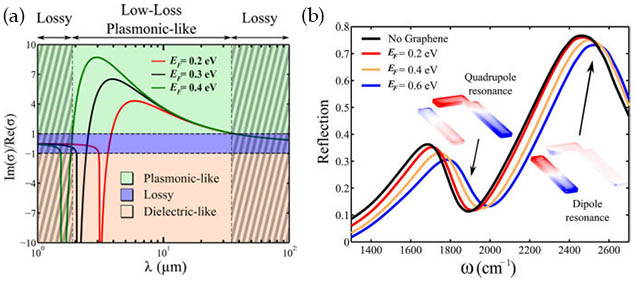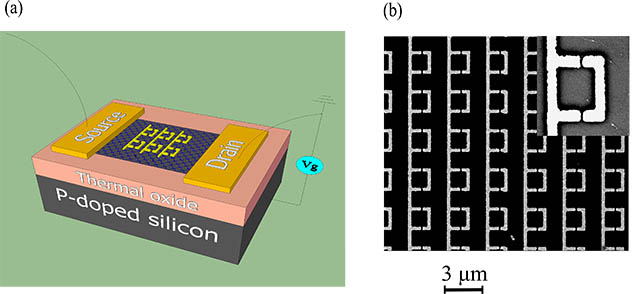Capacitive and Inductive Tuning of Meta-Surfaces Electromagnetic Response
Metamaterials are typically comprised of highly resonant plasmonic elements which have a spectrally-narrow response. The ability to actively control the resonant constitutive elements of metamaterials enables dynamic tunability of their optical response and can potentially expand the range of their applications even further. A variety of approaches to achieving dynamic tunability have recently emerged. They rely on integrating metamaterials with various optically active materials such as semiconductors with electrically/optically controlled free carriers, liquid crystals, and nonlinear media.
To better understand the concept of frequency tuning, it is instructive to represent a resonant metasurface element as an L-C circuit possessing resonance frequency $\omega = \sqrt {LC}$. Addition of optically active materials to the resonant metasurface increases the capacitance C (due to field expulsion) and decreases the inductance L (due to image currents). However the change of C usually dominates that of L which makes blueshifting more challenging to achieve than redshifting using conventional materials. Here we propose an approach to blue-shifting metamaterials’ resonances in the mid-infrared part of the spectrum by enveloping them in a 'zero-volume' nearly-lossless plasmonic material: the single-layer grapheme (SLG). SLG, due to its vanishing out-of-plane polarizability, hence the name zero-volume, does not alter the capacitance, however, here we show both theoretically and experimentally, that it modifies the inductance, and accordingly induces blueshifting. Based on perturbation theory, we show that spectral shift $Re \{ \Delta \omega \}$ and spectral broadening $Im \{ \Delta \omega \}$ relate to the surface conductivity of graphene $\sigma (\omega)$: $Re \{\Delta \omega \} / Im \{ \Delta \omega \} = Im \{ \sigma \} / Re \{ \sigma \}$, which we will use to extract Fermi level and scattering rate in graphene.
Inductive Tuning of Fano-Resonant Meta-Surfaces Using Plasmonic Response of Graphene in Mid-IR
To illustrate the uniqueness of the mid-IR frequency range for low-loss graphene response, we plot in Figure 1a the ratio of the reactive (inductive or capacitive) to resistive conductivities of moderately doped SLG. Clearly, the large ratio $Im (\sigma) \gg Re (\sigma)$is achieved only in the mid-IR frequency range. A metasurface composed of a periodic arrangement of a $\pi$ element was designed, which supports two resonances with distinct lifetimes: a bright dipolar mode and a dark quadrupolar mode; the interference between the two resonances results in a spectrally sharp Fano feature. Figure 1b predicts how the spectral position of both resonances blueshifts when a moderately doped single-layer graphene (SLG) is transferred onto the metasurface. The magnitude of the blueshift increases monotonically with the SLG’s Fermi level $E_F$. Because of the larger field enhancement on the surface, the shift of the quadrupolar resonance is more pronounced compared to that of the dipolar resonance.

Figure 1. (a) Mid-IR is the only spectral window where moderately-doped graphene acts as a plasmonic low-loss material. (b) Reflectivity spectra of a graphene-covered π metasurface for a y-polarized incident light as calculated from COMSOL for different values of $E_F$.
Strong Modulation of Mid-IR Light Using Electrostatic Gating of Graphene
Plasmonic metasurfaces enhance light-matter interaction by focusing light into extremely subwavelength dimensions. These carefully designed structures have been used in extremely thin optical component which can mold the wavefront with exciting applications in optical lenses and beam steering as well as biosensing applications. Adding dynamic tunability to these devices opens up the possibility for interesting application in single pixel detection and 3D imaging as well as optical modulators and switches. However the existing approaches for designing active optical devices in infrared, are either slow or have small refractive index change. Graphene-loaded plasmonic antennas was recently utilized for high-speed modulation of Infrared light However the achieved modulation depth (MD) did not exceed 30%. We take advantage of graphene integration with Fano-resonant metasurface to achieve MD of 1000%.

Figure 2. (a) Schematic of the back-gated SLG hybridized with a metamaterial (b) The SEM picture of the fabricated metasurface on top of SLG graphene. The inset show a unit cell of the MM on SLG.